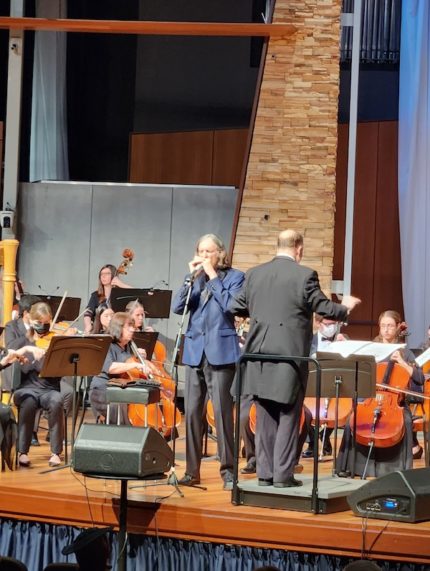Harmonica virtuoso Levy opens Elmhurst Symphony season with a blast

The Elmhurst Symphony Orchestra, led by longtime conductor Stephen Alltop, opened its season Saturday night with a program dubbed “The Amazing Howard Levy,” which lived up to its advertising at Elmhurst Christian Reformed Church.
The 71-year-old, genre-defying harmonica player was the soloist in his own Concerto for Diatonic Harmonica and Orchestra, a thoughtful and engaging work that demonstrated Levy’s vast array of innovations on the instrument.
Levy was the first person to develop a way of playing the diatonic harmonica chromatically, meaning that all 12 pitches of a chromatic scale are available to him, rather than just those “built in” to the harmonica itself. Levy’s technique has allowed the instrument to be relevant beyond its traditional blues, folk and rock contexts, and in fact the harmonica sounded quite natural in front of a symphony orchestra.
The Levy concerto, though written in 2000, is very much in the 19th-century virtuoso tradition. Cast in three movements, the score abounds in tuneful melodies and virtuosic display. The opening “Air, Jig and Reel” begins with the feel of a murky Irish moor, before opening up into an extended lilting dance, with Levy often turning arabesques over the orchestral melodies. The movement has the obligatory show-off cadenza, before closing with the briefest of orchestral punctuations.
The central “Theme and Variations” has the quality of a cinematic waltz, where Levy continued to demonstrate almost unimaginable technical possibilities. The concluding “Etude, Tango—Caprice & Finale” convincingly channeled Paganini with flurries of arpeggiation from Levy. The orchestral accompaniment is not exceptionally involved, and Alltop led this with a firm hand, only occasionally allowing the orchestral texture to cover Levy’s sensitive playing.
With his concerto lasting only about 15 minutes, encores felt suitable and Levy did not disappoint. He offered two Bach selections, a solo rendition of “Jesu, Joy of Man’s Desiring,” and the Adagio from Bach’s BWV 1030 Sonata (traditionally played on flute or oboe) with Alltop supporting from the piano.
Levy’s Bach performances were subtly blues-inflected, but what was remarkable was that he did this in a way that felt neither forced nor gimmicky. His harmonic elaborations sounded like any other more traditional ornamentation, allowing one to hear the high Baroque and the blues in conversation with each other in a fresh and unexpected manner.
After these Levy offered an extended set of solo variations on “Amazing Grace,” which he dedicated to John Coltrane. Levy again soared here, capturing both the spiritual element of the familiar hymn while further demonstrating his singular technical ingenuity.
As Alltop explained at the top of the evening, the remainder of the program featured pieces mentioned in Henry Fogel’s essay “For Pleasure’s Sake,” where he traced and lamented the decline in programming of “entertaining” works on symphony programs in the latter half of the 20th century. Thus, the balance of the evening was devoted to Smetana’s Overture to The Bartered Bride, Chabrier’s España, Rimsky-Korsakov’s Capriccio espagnol, and the Polka and Fugue from Jaromir Weinberger’s light opera Schwanda the Bagpiper.
The two Spain-inspired works fared best. España had the lighthearted elan one hopes for in this effervescent bauble, with strong contributions from the bassoon and brass sections. The soloists all acquitted themselves well in Rimsky-Korsakov’s Spanish evocation, with principal clarinet Elizandro Garcia-Montoya and concertmaster Rika Seko clear standouts. Alltop provided vigorous, assured leadership.
The orchestra struggled more in the Smetana and Weinberger, largely because of the unforgiving light these scores shine on the string sections. It is hard to imagine a more mercilessly exposed passage than the opening pages of Smetana’s Overture, which sounded more like a scurrying Ligeti texture on Saturday night.
Re-tuning before concluding the concert with Weinberger would have been wise, as the intonation in the string sections was severely compromised by this point in the evening. Nonetheless, Alltop kept his committed players unified enough to avoid catastrophe, and the dedicated Elmhurst musicians were clearly keen to show up for their maestro.
Saturday’s performance was also the first with new executive director Gregory Hughes at Elmhurst’s organizational helm. Hughes is both the artistic director and general manager of the Lakeview Orchestra, which he has developed into a formidable community ensemble, and it will be exciting to see if he can work similar magic in Elmhurst.
The Elmhurst Symphony Orchestra’s next program features Brahms’ Symphony No. 3 and Piano Concerto No. 1 with soloist Adam Neiman 4 p.m. November 13. elmhurstsymphony.org
Posted in Performances




